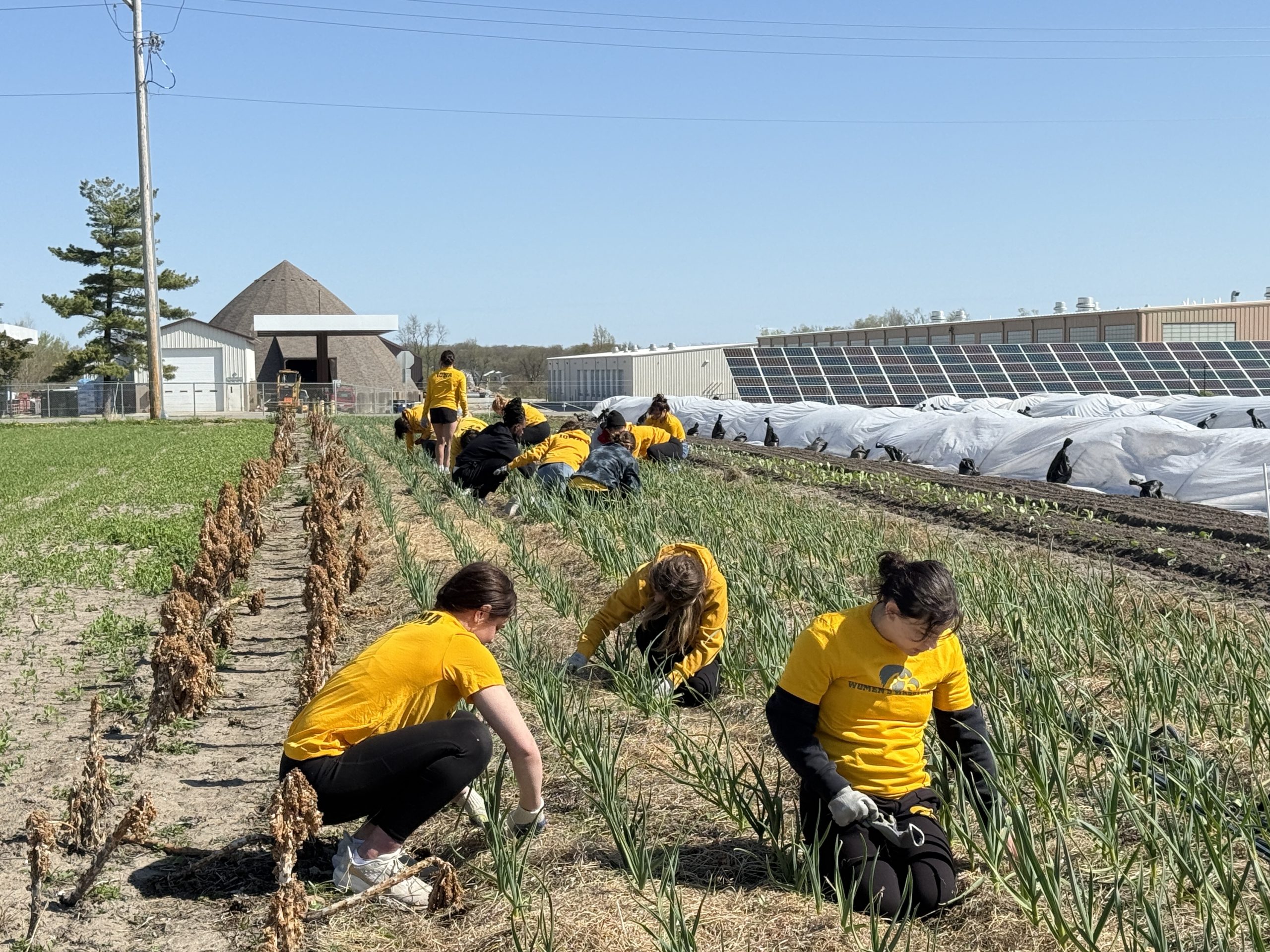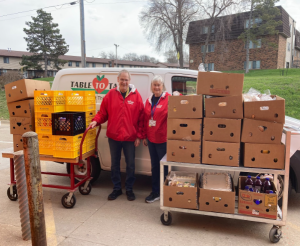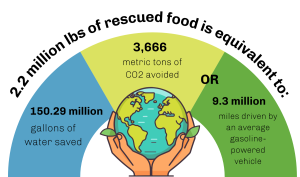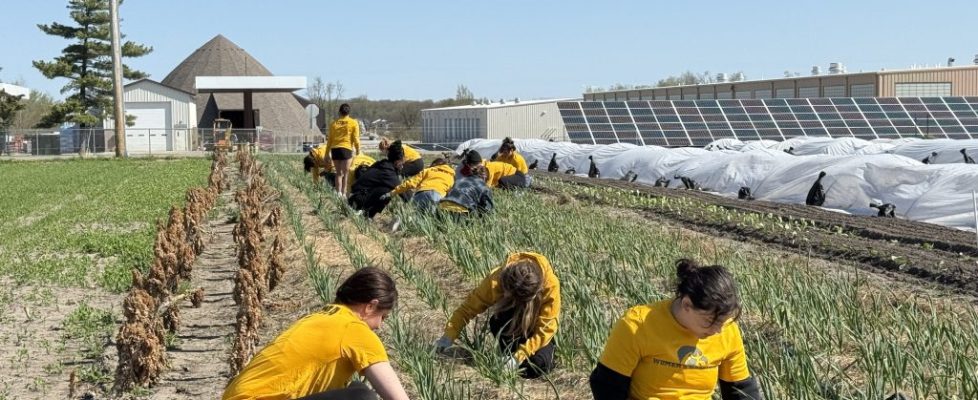
Gear Up for Gleaning Season!
What exactly does gleaning mean – no not cleaning…gleaning! If you’re unfamiliar with this weird word, don’t worry, you’re not alone. Gleaning is an age-old practice that helps provide fresh local foods to the community, so let’s dive in!
“The term gleaning is used in the agriculture industry to describe the collection of crops left in the field after all other available food has been harvested” (PostHarvest). The practice dates back centuries but is still largely relevant in modern day farming. At Table to Table, we implement gleaning into our food rescue system to provide fresh local foods for Johnson County’s food access network. Local farmers and individuals with large personal gardens reach out to us when they’ve reached their capacity for harvesting and still have good crops left in the fields. This can happen for many reasons – sometimes there is not enough people-power to harvest everything, farmers may have over-planted in case of blight, drought, or pest problems, or they may have planted cover crops to protect against erosion with no intention of harvesting them in the first place! Whatever the reason may be for excess crop, gleaning is a great way to ensure the resources used in producing the food are not wasted while getting fresh food on local tables at the same time (PostHarvest).
Want to get involved?
- Volunteer with Table to Table (T2T)!
- We’re gearing up for prime gleaning season and could use all the help we can get! Contact volunteer@table2table.org for more information on becoming a gleaning volunteer. Gleans usually take place in the morning and last around two hours. It’s a great way to get outdoors, learn more about local foods, and get your hands dirty!
- Grow a row!
- Are you an avid gardener? Got a green thumb? Just like to plant things? Plant an extra row of produce of your choosing in your personal garden or community plot to donate, and when it’s ready for harvest, bring your produce to T2T or other food access organizations in the community! For more information on this, contact gleaning@table2table.org.
- Donate produce to Table to Table!
- Are you a local grower with extra produce in your fields or garden? Connect with T2T to discuss potential gleaning opportunities! We’ll send a crew of volunteers to harvest your extra produce and deliver to food insecure neighbors. Contact gleaning@table2table.org for more information.
Just in Time, One Box at a Time
How our food rescue model sets the tone for an exceptional food access network, one of the best in the state.
Every day at Table to Table, we adapt to the unpredictability of food rescue. We’ve built a system that’s flexible enough to meet the unique needs of our neighbors. At the heart of that system is something surprisingly simple: the humble banana box—absolutely central to our mission.

Most of the food recovery work in the US is done in two models: a model relying on huge trucks and paid staff to pick up pre-packed pallets and deliver them to a warehouse for distribution days later or a model where pantries send their own staff or volunteers to the store to collect whatever food is available that day.
Table to Table is one of the few organizations across the country that uses a route based model, and the banana box is a key part of that process. Volunteers go into a food donor store and collect the donations directly from staff. They cart it out, pack it by type into 20 or more banana boxes, and deliver it directly to food access partner, like a food pantry.
With this model we prioritize dignity, supporting our belief that both people and food have inherent value. At a partner meeting just this week, folks reported that most of the food we deliver in a day is gone within 3 hours, so we know our neighbors get food to their tables as fresh as possible. When we pack food by hand, inspecting items for quality, we’re not just moving food—we’re ensuring it’s good food, worthy of the people we serve.
And our model supports equity, too. Food recovery is unpredictable. Some days a store might only have a few boxes of bread. Other days, there might be hundreds of pounds of strawberries. In a one-store-to-one-pantry model, that can be a challenge. What if a pantry doesn’t have enough patrons for all those strawberries? What if the store has nothing that day? Our volunteers visit multiple stores, and split the food into smaller manageable boxes by food type. This allows us to redistribute resources more fairly and address needs of different communities. We can make sure those strawberries are delivered to both a Head Start program and a pantry. We can also pick up and combine several small donations to create a meaningful delivery.
The banana box allows us to respond in real time, to build equity into the system with every stop.

Our volunteers aren’t just box packers. They’re relationship builders. They know the names of dairy managers and produce clerks. They handle each item that goes into a box. They check in when donations are low and thank donors in person. That daily presence makes a difference—this is why stores in Johnson County donate more food collectively than those in comparable communities.
When a volunteer delivers boxes to a partner, they’re not just unloading and leaving. They’re asking, “What do you need today?” They’re listening and noticing change. Then they’re reporting back, so we can adjust. This kind of real-time collaboration simply isn’t possible in a top-down distribution system. But when you’re handing a box of food directly to a recipient partner? You build trust. You stay connected.
Last year, volunteers distributed 2.7 million pounds of food. They packed more than 1,000 boxes a week, 52,000 boxes in a year. Volunteers are the reason we can respond quickly and distribute quality food equitably. You can join us. Whether by volunteering, donating, advocating, or simply sharing our story, you are a part of this network.
None of this would be possible without our community. We’re holding steady, because we’ve built a model rooted in adaptability and powered by people. But we also know that the road ahead won’t be easy. State and federal policies are shifting. Food insecurity is becoming more complex. And yet—we’re still here.
So, when folks ask me how we are going to meet this moment? My answer is: We will do it together and we will do it one banana box at a time.
In hope & solidarity, Nicki Ross -Executive Director
Donate Easily Online
Effects of Federal & State Policy Changes and How Can You Help?
We’ve heard you ask: “How is Table to Table faring under the changes happening at the federal and state level?” and “What can we do to help?”
Proposed cuts to federal poverty relief programs like SNAP and Medicaid will impact our neighbors’ ability to meet their basic needs.
USDA foods accounted for 17% of all the food distributed by pantries in Johnson County last year. Cuts to funding for a quarter of this food have been announced. The remaining is funded in the farm bill, but we’ve seen other congressionally funded programs axed.

~ Follow and subscribe to the Iowa Hunger Coalition to better understand the direct impacts on our neighbors. Use your voice to promote the importance of programs like USDA TEFAP, now, before we see those proposed cuts come to fruition. Read more about where state and federal legislation related to poverty/food insecurity are now in this letter from Luke Elzinga, chair of the Iowa Hunger Coalition.
T2T recently lost funding for all of our seasonal AmeriCorps roles. These members lead our seasonal local foods programs including managing over 30 farm partnerships and recovering 10% of the fresh produce we deliver.
~ Volunteer with us. We need you now more than ever. email volunteer@table2table.org to find out the many ways we can use your help.
Our partners are facing significant funding cuts for key life saving services that can’t be replaced by community funding alone. The most recent budget proposal guts HUD’s affordable housing, homelessness, and community development funding. These programs directly fund shelter/housing services and also support local funding to 20+ community agencies including Table to Table.
~ Consider increasing your gift or signing up for a monthly recurring gift. You are our lifeline —60% of our funding comes directly from individuals and local business contributions.
Donate Easily Online
Food Rescue = Climate Change
When good food ends up in the landfill, not only does the food go to waste, but every resource that went into producing, processing, transporting, and storing it is wasted as well. Each step in the food production process, including disposal when it goes unbought from stores, produces harmful emissions. Food waste ultimately accounts for 8-10% of global greenhouse gas emissions each year. Food rescue aims to reduce harmful greenhouse gas emissions by using food for its intended purpose – to be eaten. So far in FY25, T2T has rescued 2.2 million lbs. of food – that’s equivalent to nearly 2 millions meals provided. 
*Figures calculated with the ReFed Insight Engine Impact Calculator

![Picture of Jon Feaver T2T volunteer for 7 years, quote: “I can’t save the world but rescuing food is something tangible I can do to help that makes a big impact across the community.” Picture of Jim and Laurie Cubit T2T volunteers for 3 years, quote: “With Table to Table you know the food you’re rescuing is going to make it into homes within a matter of hours. Being able to make a difference that quickly is a wonderful thing.” Picture of Dina Janzen T2T volunteer for 17 years, quote: “[As a big truck volunteer] I get to move 10,000 pounds of food at a time! I can’t believe how I’ve watched this organization grow. I have loved every volunteer I’ve ever come into contact with and the staff are amazing. It’s just a really good feeling.”](https://table2table.org/wp-content/uploads/2025/05/FY25-Spring-Appeal-Menu-11-x-17-in-1-207x300.png)



